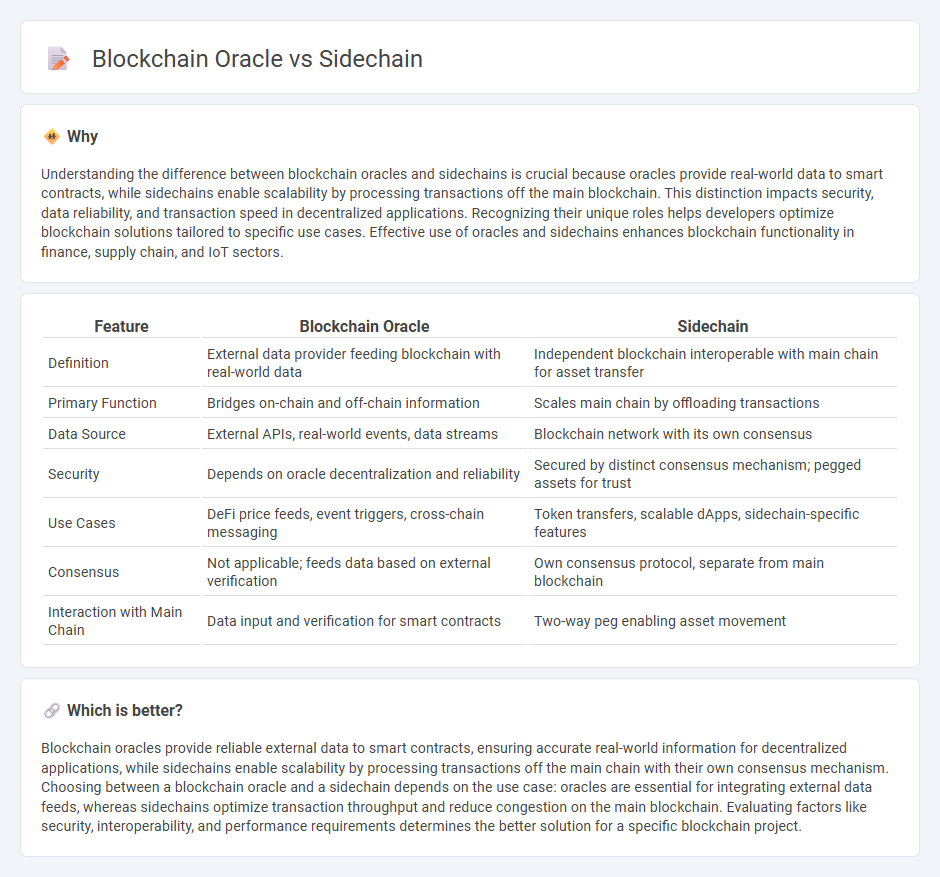
Blockchain oracles serve as trusted data feeds that enable smart contracts to interact with external information, ensuring accurate and timely inputs for decentralized applications. Sidechains operate as independent blockchains connected to the main chain, enhancing scalability and enabling custom functionalities without compromising security. Explore deeper insights into how blockchain oracles and sidechains transform decentralized ecosystems.
Why it is important
Understanding the difference between blockchain oracles and sidechains is crucial because oracles provide real-world data to smart contracts, while sidechains enable scalability by processing transactions off the main blockchain. This distinction impacts security, data reliability, and transaction speed in decentralized applications. Recognizing their unique roles helps developers optimize blockchain solutions tailored to specific use cases. Effective use of oracles and sidechains enhances blockchain functionality in finance, supply chain, and IoT sectors.
Comparison Table
| Feature | Blockchain Oracle | Sidechain |
|---|---|---|
| Definition | External data provider feeding blockchain with real-world data | Independent blockchain interoperable with main chain for asset transfer |
| Primary Function | Bridges on-chain and off-chain information | Scales main chain by offloading transactions |
| Data Source | External APIs, real-world events, data streams | Blockchain network with its own consensus |
| Security | Depends on oracle decentralization and reliability | Secured by distinct consensus mechanism; pegged assets for trust |
| Use Cases | DeFi price feeds, event triggers, cross-chain messaging | Token transfers, scalable dApps, sidechain-specific features |
| Consensus | Not applicable; feeds data based on external verification | Own consensus protocol, separate from main blockchain |
| Interaction with Main Chain | Data input and verification for smart contracts | Two-way peg enabling asset movement |
Which is better?
Blockchain oracles provide reliable external data to smart contracts, ensuring accurate real-world information for decentralized applications, while sidechains enable scalability by processing transactions off the main chain with their own consensus mechanism. Choosing between a blockchain oracle and a sidechain depends on the use case: oracles are essential for integrating external data feeds, whereas sidechains optimize transaction throughput and reduce congestion on the main blockchain. Evaluating factors like security, interoperability, and performance requirements determines the better solution for a specific blockchain project.
Connection
Blockchain oracles enable smart contracts to access real-world data, ensuring accurate execution based on external information, while sidechains provide scalable and flexible environments for offloading transactions from the main blockchain. The connection between oracles and sidechains lies in their complementary roles: oracles supply reliable data feeds that sidechains utilize to validate and process transactions efficiently. This integration enhances blockchain ecosystems by combining verified data inputs with scalable transaction handling, improving overall performance and interoperability.
Key Terms
Consensus Mechanism
Sidechains utilize independent consensus mechanisms to validate transactions and maintain security separate from their main blockchain, often employing Proof of Stake (PoS) or delegated consensus to achieve faster finality. Blockchain oracles, however, rely on external data sources with a consensus layer that aggregates and verifies off-chain information, ensuring the accuracy and reliability of smart contracts interacting with real-world data. Explore deeper into how consensus mechanisms impact the security and efficiency of sidechains and oracles in decentralized ecosystems.
Data Interoperability
Sidechains enhance data interoperability by enabling secure transfer of assets and information between distinct blockchain networks without compromising decentralization. Blockchain oracles act as trusted bridges that feed external real-world data to smart contracts on blockchains, ensuring accurate and timely information flow. Explore the comparative advantages of sidechains and oracles to deepen your understanding of decentralized data interoperability solutions.
External Data Feeds
Sidechains enable interoperability by connecting to main blockchains while processing external data feeds independently, improving scalability and customization for specific applications. Blockchain oracles serve as trusted intermediaries that fetch and verify real-world data, such as market prices or weather information, ensuring accurate and reliable input for smart contracts on the blockchain. Explore the differences and use cases of sidechains and oracles to understand how external data feeds enhance blockchain functionality.
Source and External Links
What is Sidechaining? - Sage Audio - Sidechaining is a music production technique where one audio track triggers a processor effect, commonly used to reduce volume of one track (like bass) when another (like kick drum) plays, preventing mix muddiness and improving clarity, often through "ducking" with a compressor.
What is sidechain compression? And how to use it - iZotope - Sidechain compression is a mixing technique that lowers the volume of one track in response to the signal of another, commonly used in genres like EDM to let kicks cut through by reducing competing bass frequencies, and also in radio for ducking music under dialogue.
Sidechain compression demystified: what it is and how to use it - Sidechain compression is an audio production method where one sound (sidechain input) controls the volume of another (target), often using rhythmic sounds like a kick drum to create pumping effects by dynamically reducing volume of pads or synths in sync with the beat.
 dowidth.com
dowidth.com